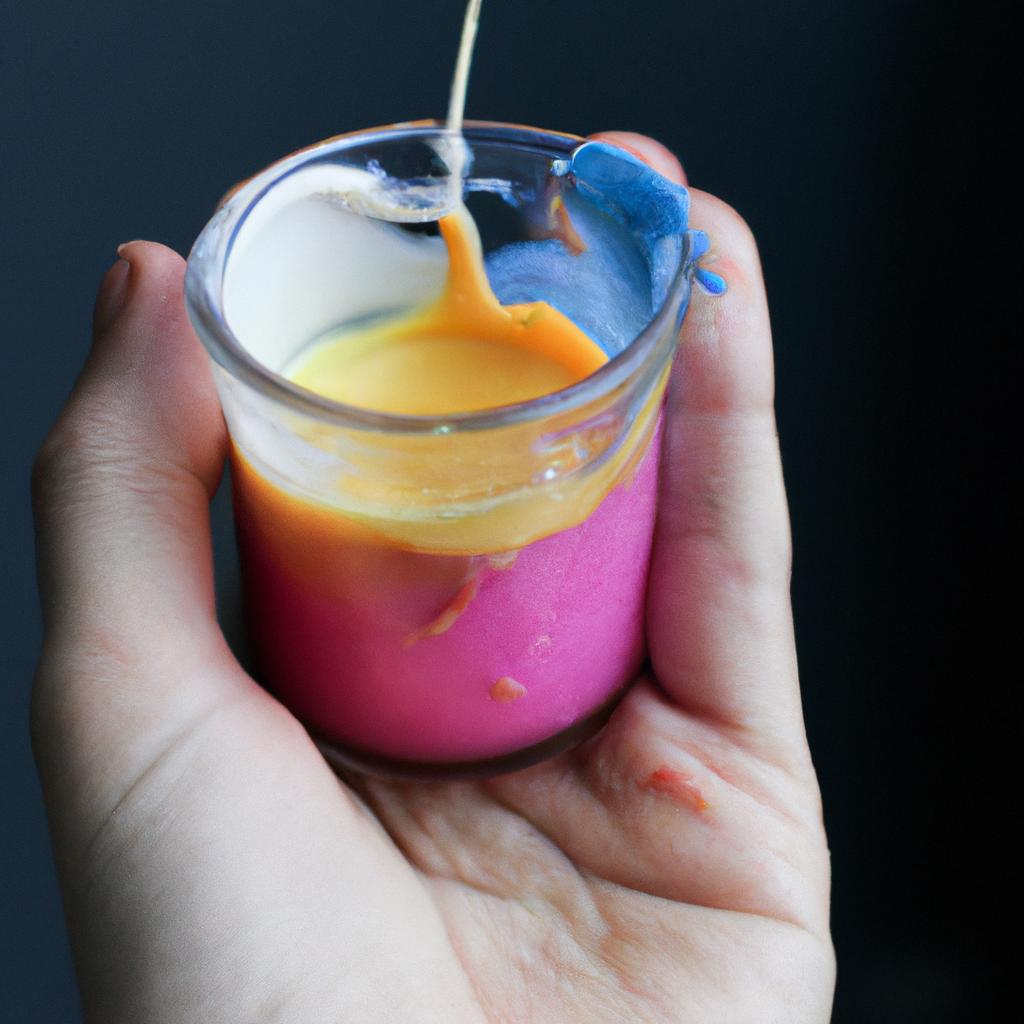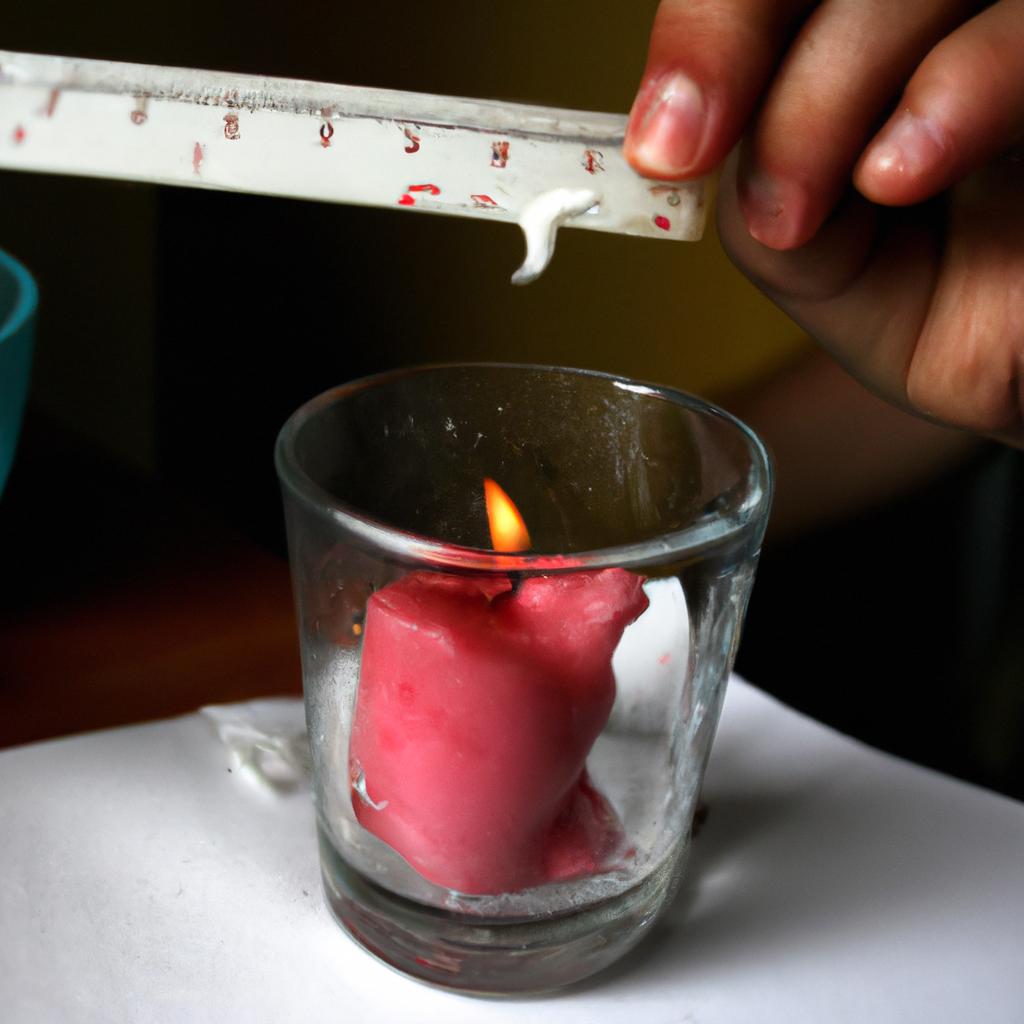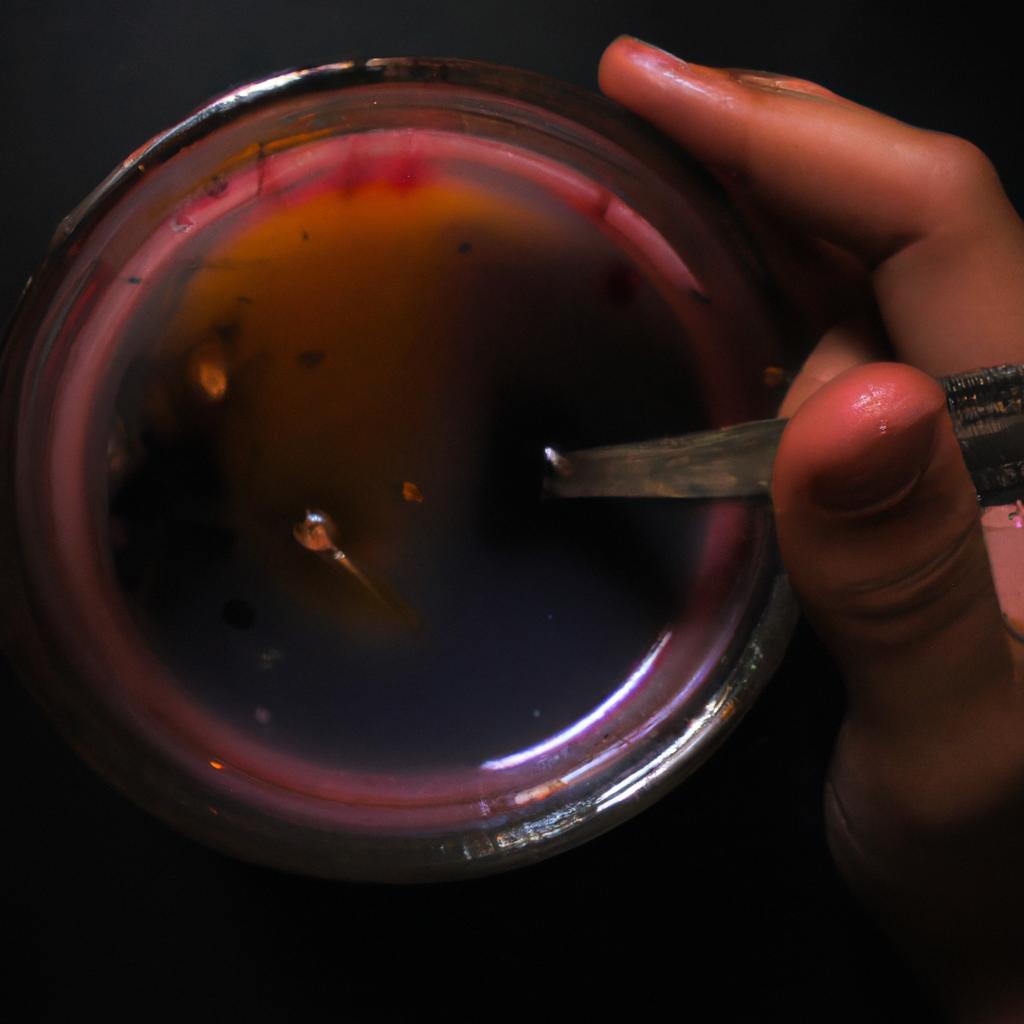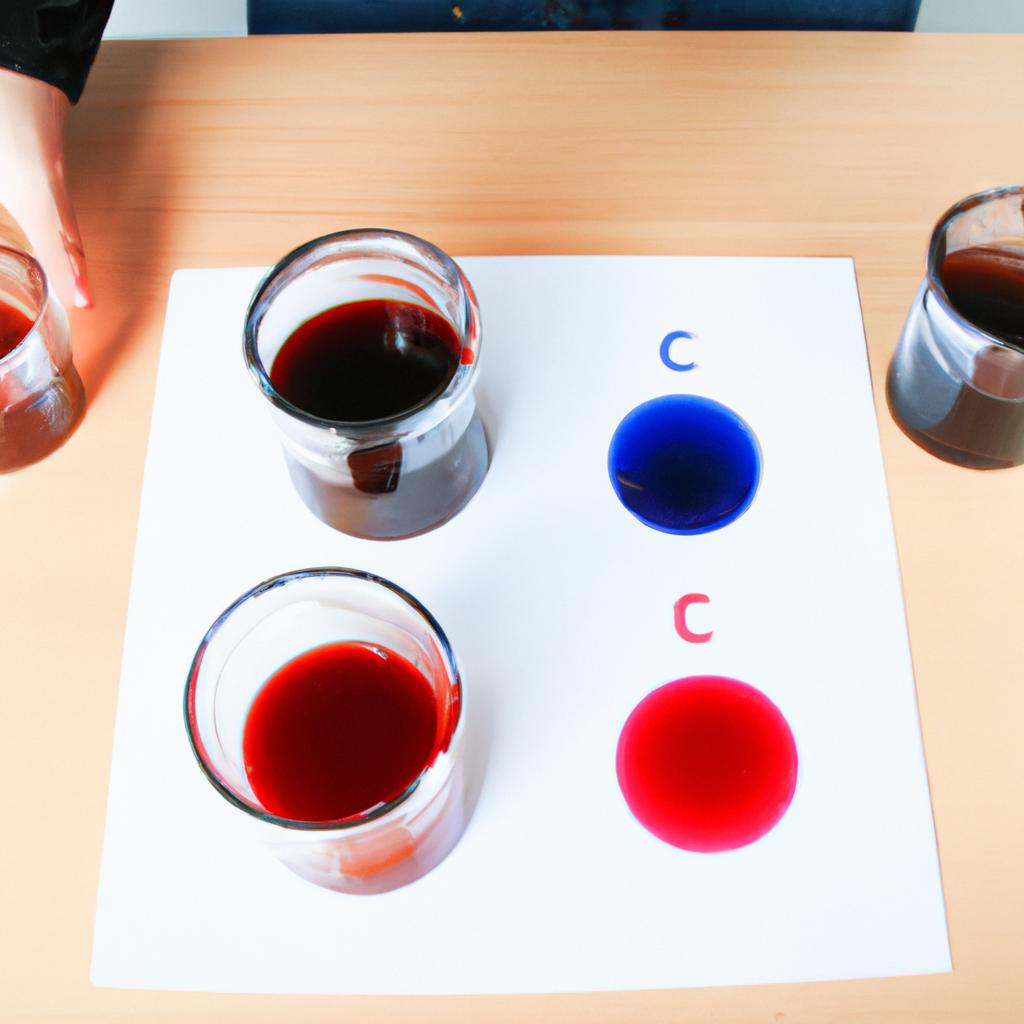Different Types of Candle Dyes: A Comprehensive Guide
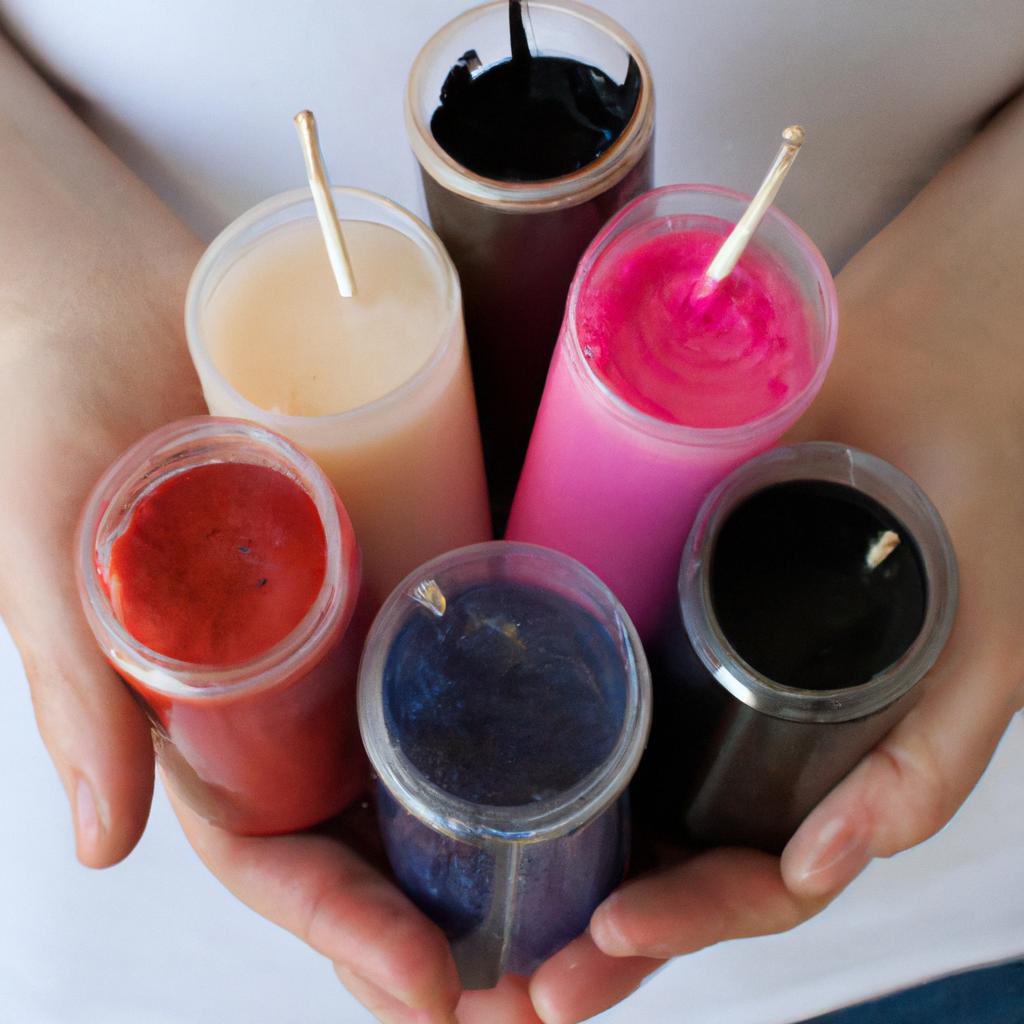
Candle making has been a popular craft for centuries, providing individuals with the opportunity to create beautiful and fragrant additions to their homes. One essential aspect of candle making is the use of dyes, which add color and vibrancy to the wax. The availability of various types of candle dyes in today’s market can be overwhelming for beginners and even experienced candle makers. To navigate through this vast selection, it is crucial to understand the different types of candle dyes available and their characteristics.
For instance, consider the case study of Sarah, an enthusiastic candle maker who recently embarked on her journey into creating scented candles as a small business venture. She quickly realized that choosing the right type of dye was just as important as selecting quality fragrance oils or waxes. Sarah initially experimented with liquid dyes but found them challenging to work with due to their unpredictable results and limited range of colors. This led her to explore other options such as powder dyes, block dyes, and even natural alternatives like vegetable-based dyes obtained from plant sources. Through trial and error, she discovered that each type had its unique features, advantages, and limitations – knowledge that proved invaluable in enhancing her candle-making skills.
In this comprehensive guide on different types of candle dyes , we will explore the characteristics of liquid dyes, powder dyes, block dyes, and natural alternatives. By understanding the pros and cons of each type, candle makers like Sarah can make informed decisions about which dye to use based on their desired outcomes.
-
Liquid Dyes:
Liquid dyes are popular among beginners due to their ease of use. They typically come in small bottles with droppers for precise color mixing. These dyes are soluble in both wax and oil, allowing for easy incorporation into candle-making processes. However, one drawback is that they can be challenging to control as they tend to spread quickly throughout the wax if not mixed thoroughly. Additionally, achieving vibrant colors can require a significant amount of dye, making it important to consider cost-effectiveness when using liquid dyes. -
Powder Dyes:
Powder dyes offer more control over color intensity as they can be added gradually until the desired shade is achieved. They come in a wide range of colors and allow for easy experimentation with custom color blends. The drawback of powder dyes is that they may not fully dissolve in the wax without proper mixing or heating techniques. It is essential to stir them well or use heat tools to ensure even distribution throughout the melted wax. -
Block Dyes:
Block dyes are convenient because they can be easily shaved or grated before adding them to the wax mixture. This allows for better control over color concentration and enables gradual adjustments during the candle-making process. However, some block dyes contain additional additives that may affect the overall quality or scent throw of the finished candles. It is crucial to choose high-quality block dyes specifically formulated for candle making. -
Natural Alternatives:
For those seeking more eco-friendly options or looking to experiment with unique colors derived from natural sources, vegetable-based or plant-based dyes can be a great choice. These natural alternatives often produce softer hues compared to synthetic dyes. However, they may require additional steps like infusion or extraction processes to obtain the desired color pigment. It is important to note that natural dyes may also have limitations in terms of color range and stability over time.
In conclusion, understanding the characteristics of different types of candle dyes is essential for successfully incorporating vibrant colors into your candle-making endeavors. Whether you opt for liquid dyes, powder dyes, block dyes, or natural alternatives, each type offers its own set of advantages and limitations. By considering factors such as ease of use, color control, cost-effectiveness, and eco-friendliness, you can make informed decisions that enhance your creativity while ensuring high-quality candles.
Natural Dyes: Exploring plant-based options
Natural Dyes: Exploring Plant-Based Options
Imagine walking into a cozy home filled with the warm glow of candles. As you inhale the soothing scent, your eyes are drawn to the vibrant colors that dance across each flickering flame. Have you ever wondered what gives these candles their rich hues? In this section, we will delve into the world of natural dyes and explore how plant-based options can enhance our candle experience.
One example of an intriguing natural dye is extracted from the roots of the madder plant (Rubia tinctorum). Historically used in textile production, madder root yields a stunning range of reds, pinks, and oranges when employed as a candle dye. This case study illustrates just one way in which nature’s palette can be harnessed to create captivating visual effects.
To further entice your imagination, consider the emotional impact that natural dyes can evoke:
- Connection with Nature: By using plant-based dyes, we establish a deeper connection with the environment around us.
- Authenticity and Craftsmanship: The use of natural dyes adds an element of authenticity and craftsmanship to hand-poured candles.
- Health Consciousness: Natural dyes are often perceived as a healthier alternative to synthetic counterparts.
- Sustainable Practices: Choosing natural dyes aligns with sustainable practices by reducing reliance on petroleum-derived products.
Now let’s take a closer look at some common plant-based dyes used in candle making:
| Dye | Source | Color Range |
|---|---|---|
| Madder Root | Rubia tinctorum | Reds, pinks, oranges |
| Indigofera Tinctoria | Indigofera tinctoria plant | Blues |
| Turmeric Powder | Curcuma longa root | Yellows |
As seen in this table, plants offer a diverse array of color options for candle makers seeking unique and natural designs. By harnessing the power of nature, candle enthusiasts can create visually stunning products while minimizing their ecological footprint.
Transitioning into the subsequent section about synthetic dyes, we will explore a different approach to coloring candles. Synthetic Dyes: Understanding the chemical alternatives presents an alternative perspective on achieving vibrant candle pigmentation through artificial means.
Synthetic Dyes: Understanding the chemical alternatives
Exploring Natural Dyes: Harnessing the Power of Plants
Imagine you are creating a candle that embodies the vibrant hues and soothing scents of nature. With natural dyes, this vision becomes a reality. Let’s delve into the world of plant-based options for candle dyes and uncover their unique characteristics and benefits.
One fascinating example is turmeric, an ancient spice derived from the curcuma longa plant. Known for its warm yellow color, turmeric can infuse your candles with a cozy glow reminiscent of sunsets on lazy summer evenings. Its earthy aroma adds to the sensory experience, making it perfect for creating an ambiance of tranquility.
When considering natural dyes for your candles, there are several key advantages worth exploring:
- Eco-friendly: By opting for plant-based dyes, you contribute to sustainability efforts by reducing reliance on synthetic chemicals.
- Health-conscious: Natural dyes are often free from harmful toxins, providing a safer environment for both yourself and those enjoying your candles.
- Aesthetically pleasing: Each natural dye brings forth its own distinct shade, allowing you to create visually striking candles that captivate attention.
- Artistic expression: Working with natural dyes provides an opportunity to connect with nature while embracing creative experimentation.
To further illustrate the diversity of plant-based options available in candle-making, consider the following table showcasing various plants alongside their corresponding colors:
| Plant | Color |
|---|---|
| Beetroot | Deep red |
| Spinach | Green |
| Hibiscus | Pink |
| Blueberries | Purple |
As you explore these possibilities, remember that each plant possesses unique properties that impact color intensity and longevity. Experimentation is key to discovering combinations that resonate with your artistic vision.
Transitioning seamlessly into our next section about liquid dyes, we now turn our attention to examining another category of candle colorants.
Liquid Dyes: Pros and cons of using liquid-based colorants
Powder Dyes: A closer look at powdered candle dyes
Now, let us delve into another type of candle dye that is widely used in the industry: powder dyes. To illustrate their effectiveness, consider a hypothetical scenario where a candle maker wants to create vibrant purple candles for an upcoming event. They decide to experiment with different types of candle dyes and find that using powder dyes yields the desired intensity of color they are looking for.
When it comes to working with powder dyes, there are several key advantages and considerations:
- Ease of use: Powder dyes can be easily mixed into wax without requiring any additional solvents or carriers. This makes them convenient to work with since they can be added directly to the melted wax during the candle-making process.
- Color versatility: Powder dyes offer a wide range of colors and shades, allowing candle makers to achieve precise and consistent results. From bold primary hues to soft pastels, the possibilities are endless when it comes to creating unique candles.
- Blendability: One notable advantage of powder dyes is their ability to blend easily with one another. This gives candle makers greater flexibility in achieving custom shades by mixing different powders together.
- Long-lasting effects: Once incorporated into the wax, powder dyes tend to produce long-lasting color effects that remain vivid even after burning. This durability ensures that your candles maintain their aesthetic appeal throughout their lifespan.
To further understand how powder dyes compare to other types of candle colorants, let’s take a closer look at this table:
| Type | Ease of Use | Color Versatility | Blendability | Long-lasting Effects |
|---|---|---|---|---|
| Synthetic Dyes | Moderate | High | Limited | Varies |
| Liquid Dyes | High | Moderate | Limited | Varies |
| Powder Dyes | High | High | High | Consistent |
As seen in the table, powder dyes offer a high level of ease of use, color versatility, blendability, and long-lasting effects compared to synthetic and liquid dyes. These qualities make them a preferred choice for many candle makers seeking vibrant and durable results.
Transitioning into our next section about liquid dyes, we will explore their pros and cons in detail. By understanding the characteristics of different types of candle dyes, you can make informed decisions that align with your creative vision and desired outcomes.
Powder Dyes: A closer look at powdered candle dyes
Transitioning from the previous section on liquid dyes, let us now turn our attention to another popular type of candle dye: powder dyes. To illustrate their efficacy, consider this hypothetical scenario: Sarah, an experienced candle maker, wanted to create a vibrant purple candle for her friend’s birthday gift. She decided to experiment with different types of colorants and found that using a powdered dye yielded the most intense and long-lasting hue.
Powder dyes offer several advantages over other forms of colorants when it comes to candle making. Firstly, they are highly concentrated, which means that a small amount can go a long way in achieving the desired shade. This saves both time and money as fewer quantities need to be added during the mixing process. Secondly, due to their fine texture, powder dyes dissolve easily into melted wax without leaving behind any residue or clumps. This results in a smoother finished product without any unsightly specks or streaks.
- Highly concentrated pigments ensure vibrant and bold colors
- Easy dissolution into melted wax for even distribution throughout the candle
- No leftover residue or clumps after melting
- Versatility in blending different colors together to create custom shades
To provide further insight into the various aspects of powder dyes, we have compiled a table outlining some key features:
| Feature | Description |
|---|---|
| Concentration | Highly concentrated pigment content ensures vivid and striking colors |
| Dissolution | Powder form allows easy dissolution into melted wax |
| Mixability | Blend multiple powders to achieve unique shades |
| Longevity | Colors maintain their vibrancy even after prolonged burning |
As demonstrated by these benefits, powder dyes present themselves as an excellent option for avid candle makers seeking precision and versatility in their creations. By harnessing the concentrated pigments and easy dissolvability of powder dyes, candle makers can achieve an array of captivating colors that are sure to delight customers.
Transitioning smoothly into the subsequent section about dye blocks, we will now explore how pre-measured blocks simplify the coloring process while enhancing its outcomes.
Dye Blocks: How to use and benefit from pre-measured blocks
Dye Blocks: How to use and benefit from pre-measured blocks
In the previous section, we explored powdered candle dyes in detail. Now, let’s turn our attention to another popular type of candle dye: dye blocks. To illustrate their usefulness, let’s imagine a scenario where Sarah, a talented candle maker, wants to experiment with creating vibrant purple candles.
Dye blocks are conveniently pre-measured colorants that come in solid block form. They offer several benefits for candle makers like Sarah:
- Ease of Use: Unlike powders or liquid dyes that require precise measuring and mixing, dye blocks provide a hassle-free experience. Sarah simply needs to melt the desired amount of wax and add one or more dye blocks according to her preference.
- Consistency: Dye blocks ensure consistent coloring results as they are formulated with specific ratios of pigments and solvents. This consistency allows Sarah to achieve reliable and repeatable colors in her candles.
- Versatility: With dye blocks, Sarah can easily mix different colors together to create custom shades without worrying about accurate measurements each time she experiments.
- Storage Convenience: The solid block form makes it easier for Sarah to store her collection of dye blocks neatly without any spillage or mess.
To better understand the advantages of using dye blocks over other types of dyes, refer to the following comparison table:
| Powdered Dyes | Liquid Dyes | Dye Blocks | |
|---|---|---|---|
| Ease of Use | Requires mixing | Easy dispensing | Simple melting |
| Consistency | Challenging | May separate | Reliable |
| Customization | Mixing required | Limited options | Easily blendable |
| Storage Convenience | Messy | Risk of spills | Neat & compact |
As seen from this comparison, dye blocks offer Sarah a user-friendly alternative, ensuring consistent results while providing the flexibility she desires.
(Transition) Now that we have discussed the benefits of dye blocks, let’s delve into the convenience that dye chips bring to the world of candle making.
Dye Chips: Exploring the convenience of dye chips
Building upon our understanding of dye blocks, let us now delve into another popular option for candle dyes—dye chips. Similar to dye blocks, these compact colorants offer convenience and ease of use. In this section, we will explore the benefits and application methods associated with dye chips.
Dye Chips in Action:
To illustrate the effectiveness of dye chips, consider a hypothetical scenario where a candle maker wants to create a vibrant purple-colored candle. By using dye chips, they can effortlessly achieve their desired result without having to measure or mix different quantities of liquid dyes. The simplicity and accuracy offered by dye chips make them an attractive choice for both beginners and experienced candle makers alike.
Benefits of Dye Chips:
When it comes to working with dye chips, there are several notable advantages:
- Precise Color Control: Dye chips come in various shades that allow precise control over the intensity and hue of your candles.
- Easy Measurement: Each chip is pre-measured, removing the guesswork associated with measuring liquid dyes.
- Convenience: Dye chips eliminate the need for additional equipment like scales or droppers since they can be easily added directly into melted wax.
- Cost-effective: Due to their concentrated form, you may only require a small amount of dye chips compared to other types of candle dyes.
Application Methods:
To ensure optimal results when using dye chips, follow these steps:
- Select your desired shade by referring to color charts or experimenting with different combinations.
- Melt your wax at the recommended temperature specified by the manufacturer.
- Once melted, add your chosen quantity of dye chips based on personal preference or instructions provided by the manufacturer.
- Stir the mixture well, ensuring that the dye chips are fully incorporated into the wax.
Table: Pros and Cons of Dye Chips
| Pros | Cons |
|---|---|
| Precise color control | Limited variety of colors available |
| Easy to measure | May require experimentation for desired shade |
| Convenient application process | Not suitable for all types of candles |
| Cost-effective due to concentrated form | Potential staining if not mixed properly |
By incorporating dye chips into your candle making process, you can enjoy their simplicity, accuracy, and cost-effectiveness. Remember to experiment with different combinations and shades to achieve your desired results. With their ease of use, dye chips offer an excellent option for both beginners and experienced candle makers looking to add vibrant colors to their creations.



